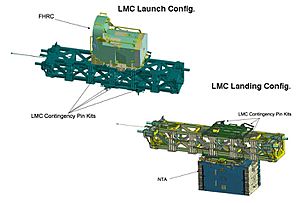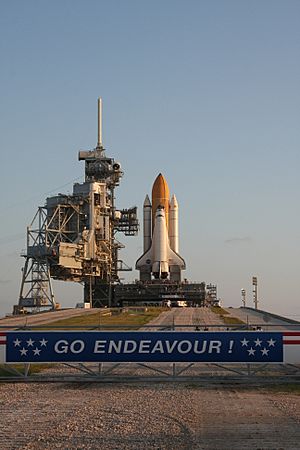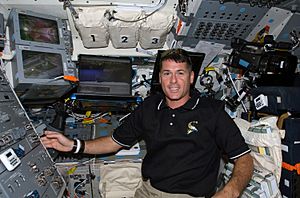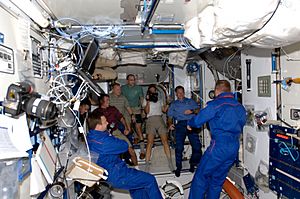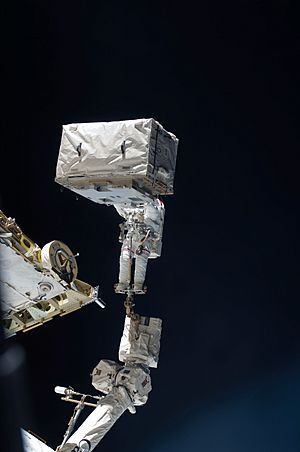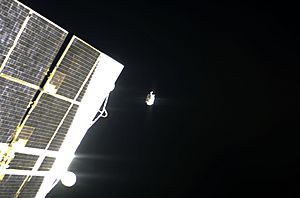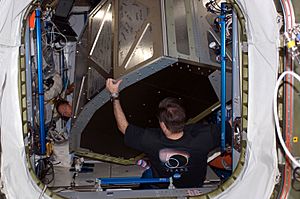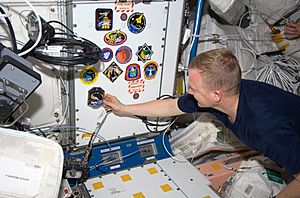STS-126 facts for kids
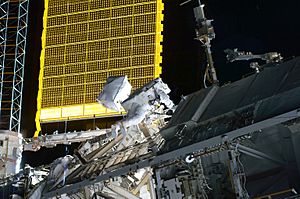
Astronaut Stephen Bowen working on the Solar Alpha Rotary Joints (SARJ) during a spacewalk.
|
|
| Names | Space Transportation System-124 |
|---|---|
| Mission type | ISS assembly |
| Operator | NASA |
| Mission duration | 15 days, 20 hours, 30 minutes, 30 seconds (achieved) |
| Distance travelled | 10,645,986 km (6,615,109 mi) |
| Orbits completed | 251 |
| Spacecraft properties | |
| Spacecraft | Space Shuttle Endeavour |
| Launch mass | 121,061 kg (266,894 lb) |
| Landing mass | 101,343 kg (223,423 lb) |
| Payload mass | 14,698 kg (32,404 lb) |
| Crew | |
| Crew size | 7 |
| Members |
|
| Launching | Sandra H. Magnus |
| Landing | Gregory E. Chamitoff |
| Start of mission | |
| Launch date | 15 November 2008, 00:55:39 UTC |
| Launch site | Kennedy Space Center, LC-39A |
| End of mission | |
| Landing date | 30 November 2008, 21:25:09 UTC |
| Landing site | Edwards Air Force Base, Runway 4L |
| Orbital parameters | |
| Reference system | Geocentric orbit |
| Regime | Low Earth orbit |
| Perigee | 343 km (213 mi) |
| Apogee | 352 km (219 mi) |
| Inclination | 51.60° |
| Period | 91.60 minutes |
| Docking with International Space Station | |
| Docking port | PMA-2 (Harmony forward) |
| Docking date | 16 November 2008, 22:01 UTC |
| Undocking date | 28 November 2008, 14:47 UTC |
| Time docked | 11 days, 16 hours, 46 minutes |
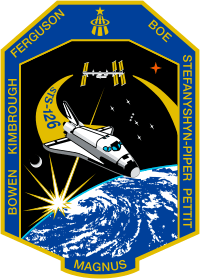 STS-126 mission patch 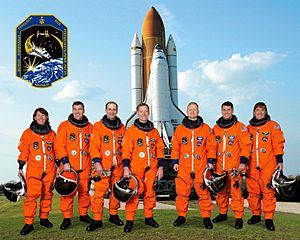 Sandra H. Magnus, Stephen G. Bowen, Donald R. Pettit, Christopher J. Ferguson, Eric A. Boe, Robert S. Kimbrough, Heidemarie M. Stefanyshyn-Piper |
|
STS-126 was a NASA Space Shuttle mission that flew to the International Space Station (ISS). It was the 124th Space Shuttle mission and the 22nd flight of the Space Shuttle Endeavour.
The main goal of the mission, also called ULF2, was to deliver important equipment and supplies to the space station. The crew also worked to fix and service the Solar Alpha Rotary Joints (SARJ). These large joints help the station's solar panels turn to face the Sun. One of them, the starboard SARJ, had been having problems since 2007.
STS-126 launched on November 15, 2008, from Launch Pad 39A in Florida. Endeavour successfully connected with the station on November 16, 2008. The crew spent over 15 days in space, including 11 days docked to the station. During this time, they performed four spacewalks and moved a lot of cargo. Due to bad weather in Florida, Endeavour landed at Edwards Air Force Base in California on November 30, 2008.
Contents
- Meet the Astronauts: STS-126 Crew
- Mission Goals and Cargo
- Shuttle Preparations for Launch
- Mission Journey: Day by Day
- Launch Day: November 14-15, 2008
- Day 2: Checking the Shuttle's Health
- Day 3: Docking with the Space Station
- Day 4: Moving Cargo and Preparing for Spacewalks
- Day 5: First Spacewalk and a Lost Tool Bag
- Day 6: Cargo Transfers Continue
- Day 7: Second Spacewalk and ISS Anniversary
- Day 8: Station Reboost and News Conference
- Day 9: Third Spacewalk for SARJ Repair
- Day 10: Continuing Water System Work
- Day 11: Final Spacewalk and Mission Extension
- Day 12: Water System Progress and SARJ Test
- Day 13: Moving Leonardo Back to Shuttle
- Day 14: Farewell and Hatch Closure
- Day 15: Undocking and Shuttle Inspection
- Day 16: Preparing for Landing
- Day 17: Landing at Edwards Air Force Base
- Spacewalks: Working Outside the Station
- Wake-Up Songs in Space
- Images for kids
- See also
Meet the Astronauts: STS-126 Crew
The STS-126 mission had a crew of seven astronauts. Here's who was on board:
| Position | Launching Astronaut | Landing Astronaut |
|---|---|---|
| Commander | Christopher J. Ferguson Second spaceflight |
|
| Pilot | Eric A. Boe First spaceflight |
|
| Mission Specialist 1 | Donald R. Pettit Second spaceflight |
|
| Mission Specialist 2 | Stephen G. Bowen First spaceflight |
|
| Mission Specialist 3 | Heidemarie M. Stefanyshyn-Piper Second and last spaceflight |
|
| Mission Specialist 4 | Robert S. Kimbrough First spaceflight |
|
| Mission Specialist 5 | Sandra H. Magnus Expedition 18 Second spaceflight ISS Flight Engineer |
Gregory E. Chamitoff Expedition 18 First spaceflight ISS Flight Engineer |
Mission Goals and Cargo
STS-126 was planned as a 16-day mission with four spacewalks. The main focus was to fix and maintain the Solar Alpha Rotary Joints (SARJ) on the space station. The starboard SARJ had been acting strangely, so its use was limited. Astronauts worked to lubricate both SARJs and replace 11 of the 12 special bearings in the starboard SARJ.
The mission also carried the Leonardo Multi-Purpose Logistics Module (MPLM). This was its fifth trip to space. Leonardo carried over 6,400 kg (14,100 pounds) of supplies and equipment.
What Supplies Did Leonardo Carry?
Some of the important items in Leonardo included:
- Two new sleeping areas for the crew.
- A second kitchen for the Destiny laboratory.
- A second bathroom (Waste and Hygiene Compartment).
- An advanced exercise machine (aRED).
- Two water recycling units.
- Spare parts and new science experiments.
- The GLACIER freezer, which is a special freezer for transporting and keeping science experiments very cold.
The shuttle also brought a special Thanksgiving meal for the astronauts, including irradiated turkey and candied yams. It also carried an Official Flight Kit with small gifts for people who supported the mission. Another item was a Lightweight MPESS Carrier (LMC) with a Flex Hose Rotary Coupler (FHRC) and a Nitrogen Assembly Tank.
STS-126 Cargo Breakdown
Here's a look at the main cargo carried on STS-126:
| Location | Cargo | Mass |
|---|---|---|
| Bays 1–2 | Orbiter Docking System EMU 3005 / EMU 3011 |
1,800 kg (4,000 lb) ~260 kg (570 lb) |
| Bay 3P | Shuttle Power Distribution Unit (SPDU) |
~17 kg (37 lb) |
| Bay 3S | APC/SSPL Picosat launcher PSSC Picosats |
50 kg (110 lb) 7 kg (15 lb) |
| Bay 7S | ROEU umbilical | ~79 kg (174 lb) |
| Bay 7–12 | Leonardo (MPLM FM-1) | 12,748 kg (28,105 lb) |
| Bays 13 | Lightweight MPESS Carrier (LMC) | 1,495 kg (3,296 lb) |
| Starboard Sill | Orbiter Boom Sensor System | ~382 kg (842 lb) |
| Port Sill | Canadarm 201 | 410 kg (900 lb) |
| Total: | 17,370 kg (38,290 lb) |
Educational Projects on Board
STS-126 carried the signatures of over 500,000 students. These students took part in the 2008 Student Signatures in Space program. This program is run by NASA and Lockheed Martin. Students from over 500 schools signed large posters, and their signatures were put onto a disk. This disk then flew into space on the STS-126 mission.
Agricultural Camera (AgCam)
The mission also brought the Agricultural Camera (AgCam) to the ISS. This camera helps farmers and provides learning chances for students. Students and teachers at the University of North Dakota built AgCam. Astronauts installed it in the Destiny module. Students on Earth can control the camera from their campus. They work with NASA engineers to take pictures of crops, forests, and wetlands. These pictures are taken using regular light and infrared light.
The information from AgCam helps farmers and ranchers in states like North Dakota. It helps them protect the environment. AgCam images can also help with disaster management, like watching floods or mapping wildfires.
Animal Embryo Experiments
STS-126 carried the first cow embryos and pig stem cells on an American spacecraft. This experiment studied how space affects the development of embryos. It was a joint project by ZeroGravity Inc., the University of Florida, and the USDA ARS.
Shuttle Preparations for Launch
Space Shuttle Endeavour was moved to the Vehicle Assembly Building (VAB) on September 11, 2008. It then rolled out to launch pad 39B on September 19, 2008.
Endeavour was first placed on pad 39B as a backup rescue shuttle for STS-125. This mission was supposed to service the Hubble Space Telescope. If Atlantis had a problem, Endeavour would launch to rescue its crew. Having two shuttles ready on the pads was a rare event, happening only 18 times.
However, on September 29, 2008, NASA decided to delay STS-125 until 2009. This was because the Hubble telescope had a problem that needed to be fixed before the mission. So, STS-126 became the next flight. On October 23, 2008, Endeavour was moved from pad 39B to pad 39A. The cargo for STS-126, including the Leonardo module, arrived at pad 39A on October 22, 2008.
Mission Journey: Day by Day
Launch Day: November 14-15, 2008
The countdown for launch began on November 11, 2008. The crew arrived at Kennedy Space Center to get ready. On November 12, the mission team gave the final "go" for launch. The weather forecast for launch day was 70% good.
On November 14, the external tank was filled with fuel. The crew got into their suits and arrived at the launch pad. They entered Endeavour and got ready for liftoff. Despite a small issue with a door, Endeavour launched on time at 00:55:39 UTC on November 15. The external tank separated a few minutes later.
Once in orbit, the crew opened the shuttle's cargo bay doors. They also set up the shuttle's robotic arm, called the Canadarm.
Day 2: Checking the Shuttle's Health
On the second day, the crew inspected Endeavour's heat shield. They used the robotic arm and a special boom with cameras to take detailed pictures. These images were sent to experts on Earth to check for any damage. The crew also got ready to dock with the space station. They extended the docking ring and prepared tools. They also checked the spacesuits for the upcoming spacewalks.
NASA noticed a small piece of thermal blanket that seemed to come loose. However, it was in an area that doesn't get very hot during reentry. Later checks showed no damage. There were also minor issues with the shuttle's Ku-band antenna, but these did not affect the mission.
Day 3: Docking with the Space Station
After waking up, the crew prepared to meet and dock with the space station. The shuttle performed a final engine burn to get closer. Commander Christopher Ferguson manually guided Endeavour to fly below the station. This allowed the station crew to take high-resolution pictures of the shuttle's underside. These images helped NASA check the shuttle's heat shield.
Endeavour successfully docked with the ISS at 22:01 UTC. The hatches opened at 00:16 UTC. The two crews greeted each other and had a safety briefing. Astronaut Sandra Magnus officially joined the Expedition 18 crew on the station.
NASA confirmed that the shuttle's heat shield looked good. The small issue seen during launch was likely ice and did not cause any damage.
Day 4: Moving Cargo and Preparing for Spacewalks
The crews began moving the Leonardo cargo module from the shuttle's bay. Using the station's Canadarm2, they moved the 12,247 kg (27,000 pound) module. It was locked into place on the Harmony module. After checking for leaks, the hatch was opened. Cargo transfer began soon after.
The crew also worked on science experiments, including one with spiders and butterflies in space. This experiment compared spider webs made in microgravity to those on Earth.
Later, astronauts Heidemarie Stefanyshyn-Piper and Stephen Bowen prepared for the first spacewalk. They spent the night in the Quest airlock at a lower air pressure. This helps their bodies get used to the spacesuit environment faster.
NASA confirmed that the shuttle's wing leading edge was clear of damage. The shuttle was in great shape for its return to Earth.
Day 5: First Spacewalk and a Lost Tool Bag
The first spacewalk began at 18:09 UTC. Astronaut Heidemarie Stefanyshyn-Piper became the first female lead spacewalker. While working on the SARJ, she noticed a lot of grease in her tool bag. As she cleaned it up, one of her tool bags floated away. The bag floated away from the station and did not pose a danger.
After checking, ground control found that astronaut Bowen had all the same tools in his bag. So, they shared equipment. The spacewalk took a little longer, but all tasks were completed. The lost tool bag was worth about US$100,000. NASA explained that human error can happen, and they would learn from it. They planned to attach grease guns to the outside of bags in the future.
Day 6: Cargo Transfers Continue
This day was focused on moving cargo. Astronauts Sandra Magnus and Gregory Chamitoff installed two new crew sleeping areas in the Harmony module. They also moved equipment to be returned to Earth into the Leonardo module. About 25% of all cargo transfers were completed, which was ahead of schedule.
The crews also started activating the new Water Recovery System. This system cleans and recycles water on the station. Later, Stefanyshyn-Piper and Kimbrough prepared for the second spacewalk by sleeping in the airlock.
Day 7: Second Spacewalk and ISS Anniversary
On the tenth anniversary of the International Space Station, Stefanyshyn-Piper and Kimbrough performed the second spacewalk. It lasted 6 hours and 45 minutes, and all tasks were completed. They moved two equipment carts and lubricated the station's robotic arm. Work on the starboard SARJ continued. Inside the station, cargo transfers and water system activation continued.
Day 8: Station Reboost and News Conference
The crews continued their work. Astronauts Michael Fincke and Sandra Magnus tested latches for the Japanese Kibo laboratory. Engineers on the ground worked to fix an issue with the Urine Processor Assembly (UPA), part of the water recycling system.
Later, Commander Ferguson and Pilot Boe used the shuttle's engines to boost the station's altitude by about 1.9 km (1.2 miles). This prepared the station for the next supply ship. The two crews also held a news conference, answering questions from reporters worldwide. Cargo transfers were about 75% complete. Stefanyshyn-Piper and Bowen prepared for the third spacewalk.
Day 9: Third Spacewalk for SARJ Repair
The third spacewalk began at 18:01 UTC. This spacewalk was entirely dedicated to cleaning, lubricating, and replacing bearings on the starboard SARJ. Almost all tasks were completed, with only one bearing replacement left for the next spacewalk. Stefanyshyn-Piper's total spacewalk time reached over 33 hours.
On the station, crews continued cargo transfers and worked on the water recycling system. A water sample was taken to be returned to Earth for testing.
Day 10: Continuing Water System Work
The crews continued transferring cargo. Astronauts Michael Fincke and Donald Pettit worked to fix the Urine Processing Assembly (UPA). The unit kept shutting down, and engineers on the ground were trying to find the cause. NASA managers considered extending the mission by one day to help fix the water system. The Endeavour crew also had some free time and spoke with media.
Day 11: Final Spacewalk and Mission Extension
The mission's final spacewalk began at 18:24 UTC, performed by Stephen Bowen and Shane Kimbrough. Just before the spacewalk, NASA announced that the mission would be extended by one day. This extra time would allow more work on the Urine Processing Assembly. The spacewalk ended after 6 hours and 7 minutes. The total spacewalk time for the mission was 26 hours and 41 minutes.
Day 12: Water System Progress and SARJ Test
The crews spent most of the day finishing cargo transfers. The starboard Solar Alpha Rotary Joint (SARJ) successfully tracked the Sun automatically for the first time in over a year. This was a great sign that the repairs worked. The Urine Processor Assembly also completed its second full five-hour run.
NASA managers were encouraged by the water recycling system's progress. More water samples were taken for testing on Earth. Astronauts on the station would not drink the recycled water until it was fully tested. The initial results for the SARJ repairs were also very positive.
Day 13: Moving Leonardo Back to Shuttle
Astronauts Donald Pettit and Shane Kimbrough used the station's Canadarm2 to move the Leonardo module. They placed it back into the shuttle's cargo bay. Heidemarie Stefanyshyn-Piper packed up spacewalk equipment for return to Earth. Sandra Magnus continued working on the station's new life support system. She collected more water samples for testing.
Day 14: Farewell and Hatch Closure
On their last day together, the two crews had some free time. They spoke to reporters and shared a Thanksgiving meal. After the meal, they finished any last-minute transfers. Then, they gathered to say goodbye. The hatches between the shuttle and station were closed at 23:31 UTC. The Endeavour crew prepared for undocking the next day.
Day 15: Undocking and Shuttle Inspection
Endeavour undocked from the International Space Station at 14:47 UTC. The shuttle had been docked for 11 days, 16 hours, and 46 minutes. This made it the second-longest shuttle mission docked to the station. Pilot Eric Boe flew the shuttle around the station for a final inspection.
The final separation burn was delayed to avoid space debris from a Russian satellite. NASA decided it was safer to delay the burn. After separating, the Endeavour crew inspected the shuttle's heat shield again using the robotic arm.
Day 16: Preparing for Landing
After the final inspection, NASA officially cleared Endeavour for reentry. The crew spent the day getting ready for landing. They checked the shuttle's flight controls and thrusters. Near the end of the day, a small satellite called Picosat was deployed. This satellite tested new types of solar cells.
Due to bad weather forecasts at Kennedy Space Center, mission managers decided to prepare for landing at Edwards Air Force Base in California. Thunderstorms and high winds were expected in Florida.
Day 17: Landing at Edwards Air Force Base
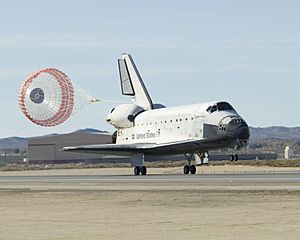
The Endeavour crew prepared for reentry. Due to strong crosswinds and thunderstorms, the landing opportunities at Kennedy Space Center were canceled. Mission managers decided to land at Edwards Air Force Base. The deorbit burn began at 20:19 UTC. Endeavour landed at Edwards Air Force Base at 21:25 UTC.
STS-126 was the only mission to land on a temporary runway at Edwards. The main runway was being repaired. This temporary runway was shorter, so new braking methods were used. This was Endeavour's last landing at Edwards.
Endeavour was later flown back to Kennedy Space Center on top of a special 747 Shuttle Carrier Aircraft. It arrived on December 12, 2008.
Spacewalks: Working Outside the Station
Four spacewalks, also called Extravehicular Activities (EVAs), were completed during STS-126. Astronauts spent a total of 26 hours and 41 minutes working outside the space station.
| EVA | Spacewalkers | Start (UTC) | End (UTC) | Duration |
|---|---|---|---|---|
| EVA 1 | Heidemarie M. Stefanyshyn-Piper Stephen G. Bowen |
18 November 2008 18:09 |
19 November 2008 01:01 |
6 hours, 52 minutes |
| The astronauts moved an empty nitrogen tank, transferred a new hose part, and began cleaning and lubricating the starboard Solar Alpha Rotary Joint (SARJ). They also started replacing its bearings. | ||||
| EVA 2 | Stefanyshyn-Piper Robert S. Kimbrough |
20 November 2008 17:58 |
21 November 2008 00:43 |
6 hours, 45 minutes |
| They moved two equipment carts, lubricated the station's robotic arm, and continued working on the starboard SARJ. | ||||
| EVA 3 | Stefanyshyn-Piper Bowen |
22 November 2008 18:01 |
23 November 2008 00:58 |
6 hours, 57 minutes |
| The spacewalkers finished cleaning, lubricating, and replacing almost all the bearings on the starboard SARJ. | ||||
| EVA 4 | Bowen Kimbrough |
24 November 2008 18:24 |
25 November 2008 00:31 |
6 hours, 7 minutes |
| They completed the last bearing replacement on the starboard SARJ, lubricated the port SARJ, installed a video camera, and performed other maintenance tasks on the Kibō module. | ||||
Wake-Up Songs in Space
NASA has a fun tradition of playing music to wake up astronauts in space. This started during the Project Gemini missions. Each song is chosen specially, often by the astronauts' families. The songs usually have a special meaning to an astronaut or relate to their daily tasks.
| Flight Day | Song | Artist/Composer | Played for | Links |
|---|---|---|---|---|
| Day 2 | Shelter | Xavier Rudd | Christopher Ferguson | WAV MP3 TRANSCRIPT |
| Day 3 | Start Me Up | the Rolling Stones | Sandra Magnus | WAV MP3 TRANSCRIPT |
| Day 4 | London Calling | the Clash | Steve Bowen | WAV MP3 TRANSCRIPT |
| Day 5 | City of Blinding Lights | U2 | Shane Kimbrough | WAV MP3 TRANSCRIPT |
| Day 6 | Fanfare for the Common Man | Aaron Copland | Eric Boe | WAV MP3 TRANSCRIPT |
| Day 7 | Summertime | Bandella | Don Pettit | WAV MP3 TRANSCRIPT |
| Day 8 | Unharness Your Horses, Boys | The Ukrainians | Heidemarie Stefanyshyn-Piper | WAV MP3 TRANSCRIPT |
| Day 9 | You Are Here | Dutton | Shane Kimbrough | WAV MP3 TRANSCRIPT |
| Day 10 | Can't Take My Eyes Off You | Frankie Valli | Christopher Ferguson | WAV MP3 TRANSCRIPT |
| Day 11 | Can't Stop Loving You | Van Halen | Heidemarie Stefanyshyn-Piper | WAV MP3 TRANSCRIPT |
| Day 12 | Fever | Bandella | Donald Pettit | WAV MP3 TRANSCRIPT |
| Day 13 | North Sea Oil | Jethro Tull | Steve Bowen | WAV MP3 TRANSCRIPT |
| Day 14 | Hold On Tight | Electric Light Orchestra | Heidemarie Stefanyshyn-Piper | WAV MP3 TRANSCRIPT |
| Day 15 | In the Meantime | Spacehog | Eric Boe | WAV MP3 TRANSCRIPT |
| Day 16 | Twinkle, Twinkle, Little Star | Gregory Chamitoff | WAV MP3 TRANSCRIPT |
|
| Day 17 | Gonna Fly Now | Bill Conti | Christopher Ferguson | WAV MP3 TRANSCRIPT |
Images for kids
See also
 In Spanish: STS-126 para niños
In Spanish: STS-126 para niños


